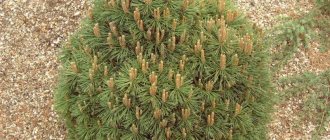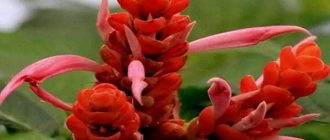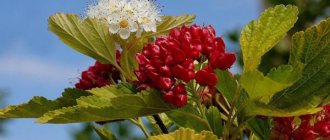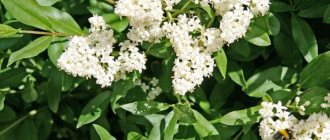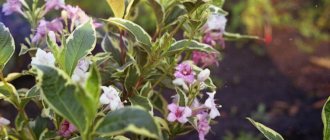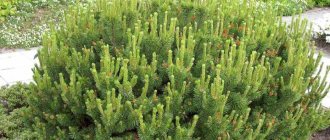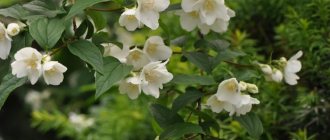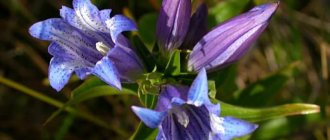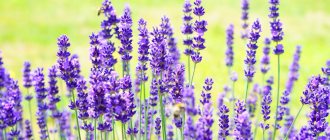Description and dimensions of the tree
Mountain pine is a coniferous plant, tree or multi-stemmed branched shrub. Usually not very high (up to 7–8 m), but sometimes reaches 10 m. The branches and trunk are covered with gray-brown scaly bark, which peels off unevenly. Noticeable species characteristic: the shade of the bark is uneven throughout the tree.
It is darker below than above. Young shoots are initially light green, then become dark brown, and then completely violet-brown. The needles are dark green, slightly glossy, densely covering the shoots. The needles are slightly twisted or curved.
Did you know? There are about 200 species of pine trees in the world, half of which grow in Russia.
The flowering period occurs at the end of May - beginning of June. At this time, the plant changes greatly. Near the base, beautiful yellow and pink male spikelets appear, decorating the bush. Female cones open on a straight, short stalk. Cones are single or paired, triple. They are 2–7 cm long and 1.5–2 cm wide. The seeds in them are small, dark, ovoid. The cones ripen towards the end of next year. Only pine trees older than 6–10 years can bloom and bear fruit. Mountain pines live for about 1000 years.
Video: The best varieties of mountain pines

Mountain pine varieties
The decorative coniferous species has been known as an element of gardening art since the end of the 18th century. It appeared in Russia at the beginning of the 19th century. Now experts count more than 120 species and varieties of mountain pine of dwarf and miniature forms. Many plants are very similar to each other. Various varieties of 2 forms of mountain culture are popular:
- Mugus is actually a shrub;
- Pumilio is an elfin variety.
Dwarf
Gnom is a dwarf variety from Holland with an oval-round, dense crown that has been decorating gardens for almost a century. The maximum height is 2 m, spreading only 80-90 cm in circumference. Dark green needles up to 4 cm thick cover the shoot. Gnome pine loves sunny exposure and grows well in cities.

Cockade
A variety of mountain shrub with original colored needles, as if sparkling from afar, was bred in the middle of the last century in Germany. The spreading crown with irregular shoots rises up to 1.5 m. The interesting effect of the color of the needles, which is called “dragon’s eye,” is especially noticeable when looking at the shoot from above. Green needles are colored yellow first at the base and then at the tops. Their combination creates the impression of a double bright ring. Kokarde pine is planted in partial shade to protect it from spring scorching.
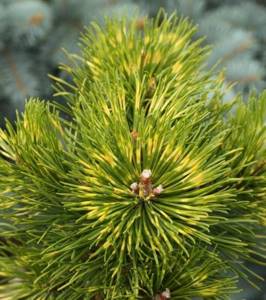
Pumilio
Pumilio is a seedling of a wild mountain bush. The height can vary, on average the plant rises to 1.5-2 m. Creeping shoots form a very outstretched crown - up to 3 m in diameter. Pine is unpretentious, easily tolerates pruning, and is resistant to weather conditions in the middle zone. The hard needles are dark green in color, medium in size, up to 4 cm. The cones are lilac in color, slightly rounded.
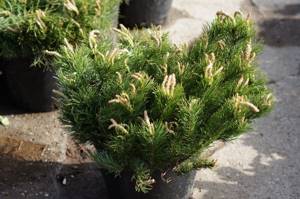
Khnizdo
According to the description of the mountain pine variety Hnizdo, which was bred by Czech breeders at the end of the last century, the plant has a curious shape of a compact crown. In the center the shoots are shorter, which creates the impression of a smooth depression in the shape of a nest. From the beginning of growth, the silhouette of the dwarf pine variety is spherical, and then becomes cushion-shaped. The growth is slow: by the age of 20 it gains up to 1-1.2 m in height, and also spreads up to 1.2 m in width. Branches with dense but short, up to 2 cm, needles are densely spaced. Small cones up to 3 cm long. The needles do not fade in the spring sun and develop well in partial shade.
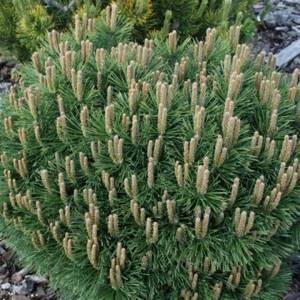
Algau
The dwarf pine of Dutch selection, the prototype of which was found in the German Alps, is not tall. In adulthood, Allgau rises from 0.7 to 1 m, covering an area of up to 1-1.2 m in circumference. This unpretentious variety of mountain shrub has a high level of decorativeness, thanks to its dense, lush crown in the shape of a sphere. Dark green needles are collected 2 in a bunch. Quite long and stiff needles, slightly curled at the tops. The variety of low pine is not planted in the shade on dense soil. The seedlings are covered for the winter.
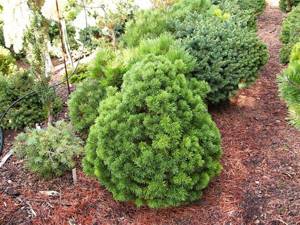
Sunshine
The charming variety of mountain pine shrub Sunshine captivates with its luminous halo, which is created by the two-color color of the needles. Long arched needles, creamy yellow at the base, becoming bright green towards the top. The arrangement of needles is dense, the branches form a loose, rounded crown. The light stripe changes in intensity: young needles are lighter in summer, and with the onset of winter they turn yellow. Sunshine pine is best planted in a sunny area where loam predominates. In summer it is recommended to irrigate by sprinkling.
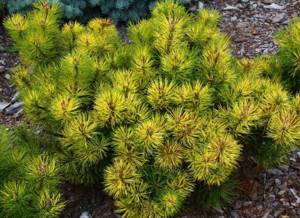
Golden Glow
Golden Glow is another luminous miniature pine shrub with a hemispherical crown that is a delight for the garden in winter. But you won’t be able to grow a seedling of this variety of dwarf mountain pine yourself from seeds. Golden Glow belongs to a species that reproduces only through grafting. Straight needles, collected 2 in a bunch, are bright green in summer. The hue changes after frost, the color brightens and becomes yellow. The annual growth is only 4 cm: at 10 years the bush reaches a height of 50 cm and 90-100 cm in diameter. Pine grows on any soil, in sunny areas. The Golden Glow variety tolerates frosts down to -34 °C.
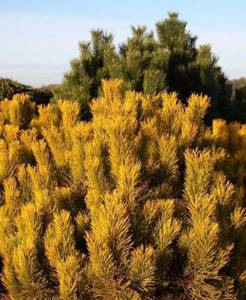
Ophir
Ophir is one of the magnificent Dutch dwarf mountain pine varieties, spread by grafting. It grows slowly: a 10-year-old specimen reaches only 40-50 cm, and a 20-year-old spherical bush rises to 80 cm with a diameter of up to 1 m. An adult plant can take on the shape of a cone. The color of the hard, short needles changes with the seasons: green in summer, golden-yellow in cold weather. Plant in the sun, adding humus and sand to the substrate. In summer, sprinkling and mulching the soil is preferable. In industrial cities, the attractive variety of evergreen mountain shrub Ophir does not develop well.
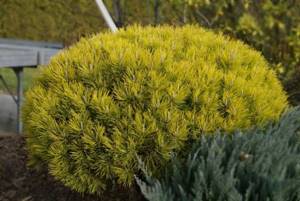
Benjamin
The miniature German variety Benjamin is often grafted onto a tall standard. This form of dwarf pine with a dense, flat-spherical crown is popular as an evergreen plant for balconies and terraces. Crown size 50-70, rarely 90-100 cm. Growth is very small, up to 3-5 cm per year. The shiny needles are dark green, stiff and short. The picky dwarf pine grows on any well-structured soil. You can try to breed a variety of mountain pine by propagation by cuttings through grafting.
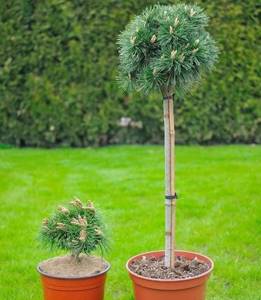
Carstens Wintergold
A very decorative dwarf variety of mountain shrub that changes color with the seasons. Brought out in the 70s of the last century in Germany through the selection of seedlings. By the age of 10 years, the hemispherical crown grows to only 40 cm, with a diameter of 90-100 cm. Dense, short branches are covered with light green needles, 3-5 cm long, which acquire a golden tone in late autumn. With frost, the shade becomes more intense, with a transition to orange and copper. By the end of winter, the crown of young seedlings is protected from burning out in the bright sun. The ovoid cones of the variety are from 2 to 6 cm, yellow-brown. Carstens Wintergold pine radically transforms the mood of the winter garden.
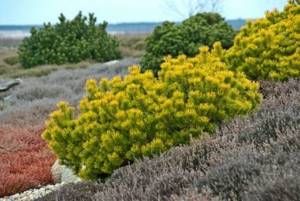
How fast it grows
Coniferous plants grow slowly. Experts divided the existing varieties of mountain pine into groups according to growth rates:
- full-grown - add 30 cm per year and at 10 years rise more than 3 m above the ground;
- semi-dwarf - add 15–30 cm annually;
- dwarf - 8–15 cm/year;
- miniature - 3–8 cm/year;
- microscopic - less than 1–3 cm/year.
Did you know? Southeast Asia is famous for the Bunge pine. Its bark is white.
Mountain pine in landscape design
Seedlings of the species live up to 1000 years in natural conditions. An established seedling is also durable. The bush will harmoniously fit into the landscape, especially enlivening it in the off-season and winter, which is poor in color. For dwarf pine, choose areas where the plant will be comfortable for years:
- rocky slopes and slopes;
- rockeries and rock gardens;
- borders, partial edging of ponds, hedges;
- in combination with deciduous shrubs with the condition of planting miniature pine varieties in the foreground, and taller ones as an evergreen background;
- background for flower arrangements of low-growing plants;
- in the group of conifers on lawns;
- for decorating the bottom plan of fences and walls of buildings.
All varieties of mountain pine bushes are suitable for decoration. Especially appreciated are those that change the color of the needles and become cheerful lanterns in winter.
Warning! Not all varieties of mountain pine bushes can withstand the gas pollution of large cities. You need to find out about the plant’s placement requirements in advance.
How to care
Coniferous plants are unpretentious. They are used to surviving in various conditions, but in order for them to quickly take root in a suburban area, they need to be properly looked after. The pine tree is irrigated three times per season. You need to pour 15–20 liters of water under one tree. If the tree trunk circle is very compacted, then it needs to be loosened before watering. When planting in spring in hot and dry summers, it is necessary to irrigate the tree more often. You can use regular sprinklers.
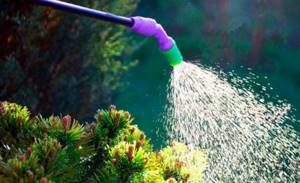
For 2–3 years after planting, mineral fertilizers must be applied annually in early spring (30–40 g per pine tree). You can use special fertilizers for coniferous plants. An adult tree does not need feeding.
Its fallen needles will serve as a source of necessary substances. In order for the pine tree to grow slowly and in the right direction, it is necessary to trim the shoots. This will make the crown thicker. Young shoots are pinched to a third of their length.
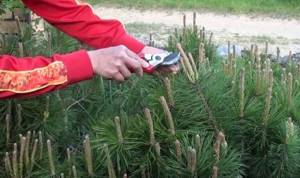
What soils to use
In nature, mountain pine is accustomed to sandy or sandy loam soil. It has a slightly acidic reaction (6–7 pH). Moisture should not stagnate at the planting site. If the site has heavy clay soil, or underground water is located close to the surface, it is necessary to drain the planting hole with a good layer of expanded clay or broken brick.
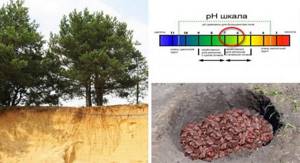
Features of care
Dwarf pines prefer light sandy and sandy loam soils; when planting them on dense clay soils, it is recommended to use expanded clay, broken brick or coarse sand to drain holes. The drainage layer should be 15-20 cm thick.
These plants do not require annual formative pruning; only dry and damaged branches are removed.
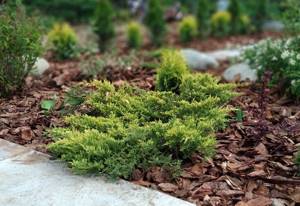
For low-growing Pínus species, moderate watering is sufficient, which is carried out with settled water in dry times. To better retain moisture, you can mulch the soil with peat or sawdust.
To feed dwarf pines, fertilizers intended for coniferous plants are used: mineral complexes Compo, Pokon, Forte. They are applied twice a season. Manure, bird droppings and other nitrogen-containing organic fertilizers are used only in diluted form so that the root system of midget plants located in the upper layers of the soil does not get burned.
Types and varieties
Mountain pine is native to the mountains of Central and Southern Europe. Typically this tree is about 200 cm tall. But there are some varieties of this plant that differ significantly in size and shape.
Alpine
Alpine pine has creeping shoots and small branches that look up. This arrangement gives the bush lushness. Rich green, hard needles densely cover the plant. In the fifth or sixth year, tiny brown cones appear on the bush. This type of pine grows well in rock gardens or in hedges around the house.
Important! When planting a pine tree in a desert area, you need to pour the Kornevin solution into the hole, and after a month add fertilizer for conifers.
Dwarf
The owner of a spherical crown. Growth is uniform and not fast, so they can rarely grow more than 150 cm. In a year it can add 2–5 cm. The species practically does not bear fruit, so it is propagated by cuttings.
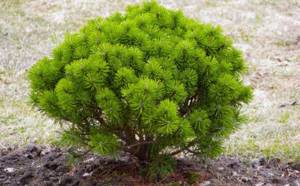
Its needles are dark green and shiny. The shoots are short, but thick and hard. Perfectly adapted to growth in city conditions. Loves the sun, withstands high humidity, drought-resistant. It tolerates haircuts well in comparison with other species, which makes the shrub an indispensable element of landscape design. Planted singly or in groups.
Video: Mountain dwarf pine
Lilliputian
A dwarf tree with a hemispherical crown. It's very dense. A 10-year-old adult shrub is no more than 50–60 cm high. The diameter of its crown is 100 cm. The plant gains 2–4 cm per year. Its needles are short and stiff. Loves sunlight and fresh, well-drained soil. It is advisable to use Liliput pine in small heather or rocky gardens.
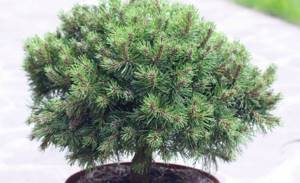
Kobold
A dwarf shrub about 100 cm in height, spherical in shape with thick branches. Its buds appear in groups of 3–5 pieces, located at a distance from each other and have different lengths. They are thick, blunt at the end, and brown in color.
The needles are straight, long (20–35 mm) and thin (1 mm) of bright green color. Propagated by seeds, cuttings and grafting. Very winter hardy. It is recommended to plant in containers for landscaping roofs and rock gardens.
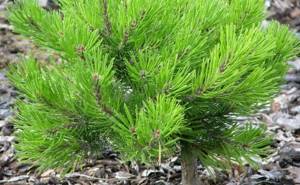
Kinds
There are several dozen varieties of the Pinus plant. They differ in trunk height, needle color, and can have a conical (pyramidal), columnar, spherical or creeping crown. The most common types of pine are:
- ordinary;
- mountain;
- cedar;
- radiata;
- Veymutova.
Related article:
Walnut at the dacha
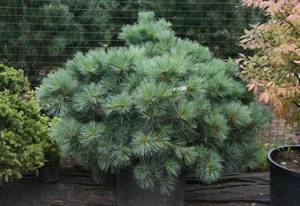
Weymouth dwarf pine
All these species have dwarf varieties. Their main difference from their tall “brothers” is their small annual growth. On average, it does not exceed five centimeters, and in tall pines it is about half a meter.
Most of the low-growing varieties were obtained through hybrid means, but there are also natural mini-pines that acquired compact sizes in the process of evolution, gradually adapting to climatic conditions.
How to propagate pine
Pine propagates by seeds and grafting. Cuttings root extremely poorly (8–10%). To collect the seed, you need to wait until the tree is 6 years old. Small cones appear at the end of autumn every two years. The seeds are collected, dried, and then planted in the spring in pots with a sandy substrate. The soil must first be treated with fungicides.
Did you know? Pinus is the Latin name for pine, which literally translates as “rock.” And all because the plant is able to attach roots even to bare stones.
Cuttings for grafting are prepared in April. The grafting procedure can be carried out in the spring or summer, in August. In the spring, a dormant scion is grafted onto a rootstock that has begun to grow. The grafted plant can be in a greenhouse or open ground.
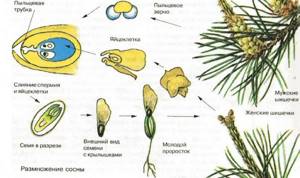
It is necessary to wait until the sap begins to flow (the appearance of candles). Coniferous plants are grafted into the butt. The junction is tightly wrapped. After the scion has clearly begun to grow, the wrapping can be loosened and, after a few months, completely removed. If such a plant successfully survives the winter, then we can say that the grafting process was successful.
Planting and growing
Container-grown mountain pine seedlings should be planted in mid to late spring or late September to early October. It is highly undesirable to plant later in the fall, since the young plant will not have time to get stronger before severe frosts.
Important! According to reviews from experienced specialists, for the southern regions the optimal time for planting is autumn, and for the middle zone and northern regions - early spring.
In order for the planted plant to quickly take root and not create problems in the future, but only please the eye, you need to adhere to some planting rules.
The ideal place for the plant is well-lit areas of the garden. Light partial shade is acceptable. In the shade, the light-loving bush will not stop growing, but it will be very slow.
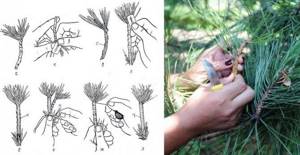
b - making a cut on the cutting; c - a cut is prepared on the cutting; d - making a cut on the apical shoot of the rootstock; d - a cut is prepared on the shoot of the rootstock; e - the cutting is placed on the exposed cambium of the rootstock; g - the cutting is pressed in rare turns to the cut on the shoot of the rootstock; h - finished grafting; C - exposed core; K - exposed cambium; N - thread clamped between the finger and the handle; H1 - end of the binding thread Measure the distance from the selected location to the foundation of the house. There must be at least 5 m so that the root system cannot destroy the building. Only a columnar or reinforced monolithic foundation can withstand pressure. It’s good if you have a rocky garden at your summer cottage where other coniferous plants grow. Important! When planting several pines, you need to maintain a distance of 150 between them.
–
200 cm.
Step-by-step description of the tree planting process:
- Prepare the planting hole. It should be comparable to the size of the earthen clod in which the seedling resides in the container. It’s optimal if you can double the size of the hole. If not, then add 15–30 cm in diameter and 20–40 cm in depth.
- Prepare the substrate: turf soil, peat, river sand (3:1:1). You can add a little complex fertilizer (20–30 g). The soil mixture must be well mixed.
- Line the bottom of the hole with drainage and on top with prepared soil.
- Carefully remove the young bush from the container and, without shaking the ground, place it in the hole. The root collar should not be buried. If it turns out below the soil level, then you should pour soil into the hole.
- Sprinkle the soil mixture onto the roots and tamp down thoroughly. Form a circle around the trunk and irrigate generously from a watering can.
- Lay a layer of peat 5–10 cm to retain moisture.
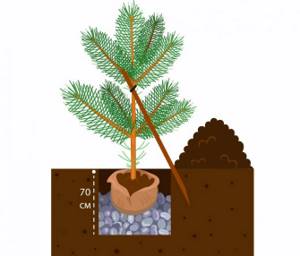
If you have patience, you can grow young pines from seeds. They can be sown either at home in pots or directly in open soil. It is advisable to plant immediately into the ground after the ground has thawed to a depth of a spade. To grow seedlings at home, sowing is carried out at the end of winter in containers 15–20 cm deep. They must be filled with an oven-calcined soil mixture of turf soil, peat and sand.
Here you can find information on how to distinguish cedar from pine.
The seeds are buried 2–3 cm, irrigated abundantly and covered with film. It is necessary to ensure that the soil is constantly moist. With the emergence of seedlings, the container must be opened and moved to a well-lit place. For sanitary purposes, young pine trees need to be sprayed with fungicides a couple of times. In early June or September, it can be planted in the soil, covered with spruce branches for the winter.
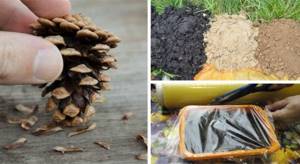
Sowing in open soil is carried out in trenches 1.5–2 shovels deep and 20–25 cm wide, pre-filled with a mixture of sand and turf soil (1:2). Grooves 30 mm deep are made in the trenches. The seed must be deepened by 2 cm and sprinkled with sand on top. During the first week, you need to water the crops a couple of times a day so that the soil does not dry out.
Pay attention to the information about how pine differs from spruce.
Starting from the eighth day, watering is gradually reduced. In two to three weeks, shoots should appear. They must be protected from direct sunlight. Once a week, to protect against fungal diseases, you should spray with a solution of potassium permanganate (the desired condition is pink).
It is advisable to replant in the fifth year of life. By this time, their height will be about 0.5 m. In winter, all young trees should be covered with spruce branches.
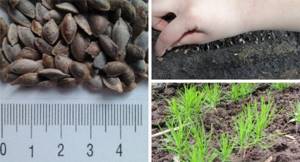
Planting a mountain pine
Mountain pines are photophilous and grow well in open areas. They are not very demanding on soil characteristics. In heavy soils, it is necessary to have a drainage system; for this, you can add gravel or sand to the bottom of the planting hole in a layer of 5-25 cm.
Mountain pine is planted at a distance of 15-5 m between plants. The average depth of the planting hole is one meter; the root collar should remain above the ground.
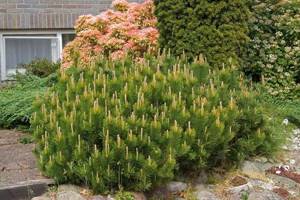
Mountain pines have a developed root system, so they are resistant to strong winds and do not require frequent watering. They can grow in open space without any consequences.
Young plants (up to 5 years old) tolerate transplantation well. Mature trees should only be replanted with a frozen ball or a prepared root system.
Pests and diseases
All plants that have needles instead of foliage are characterized by good resistance to diseases and pests. But young trees often come under attack from misfortunes. They are negatively affected by birds, weather conditions, and improper care. In a weakened state after winter or a very wet summer, pine trees are affected by a fungal disease - schutte.
The spread of infection can be stopped by treating with copper-containing preparations. All affected parts of the plant are removed and burned. For preventive purposes, during humid and hot summers, the bush is sprayed with colloidal sulfur.
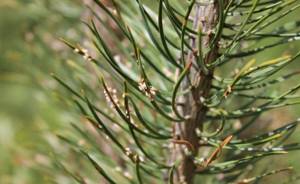
Because of it, the needles become brown with a black dot, the branches often dry out and become covered with cobwebs. The reason for this lies in insufficient hydration and lack of nutrients. A sick tree may not look decorative at all, as it often loses many needles.
Another scourge is scleroderiosis. It leads to the fact that the buds at the top of the branches begin to die, and then the branches themselves. The diseased parts of the evergreen beauty must be trimmed.
Northern weed is a disease that causes an orange coating to appear on the ends of the needles. It is caused by a rust fungus. It can be defeated only by completely removing the affected bushes.
We recommend learning about pine propagation methods.
Aphids are a common pest that spoils the beautiful appearance of pine trees. It is expelled by special drugs like Lepidocide. It is imperative to carefully care for sick trees so that they recover quickly.
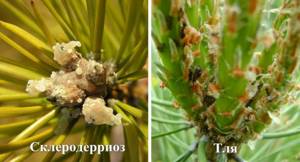
Application in landscape
The introduction of such a landscape element as mountain pine can turn your dacha into a piece of paradise. The ideal composition for an evergreen beauty is a stone garden or an alpine slide. Here, in combination with the blue spruce variety, it will look great even among the trees of the orchard.
Also learn how to plant gladioli for landscaping.
With the help of low-growing pine species it is easy to create magnificent hedges and multi-tiered compositions. This plant can be planted mixed with cereals and large-flowering shrubs.
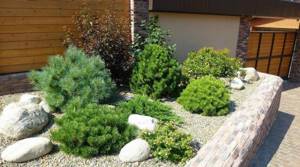
Dome-shaped varieties planted next to low maples look unusual. You can also plant it next to heather, but then there will be many problems with care due to different requirements for soil acidity. A possible solution is to create a multi-tiered landscape.
Decorating a garden plot with mountain pine is easy. This plant is unpretentious and does not require special care. It fits perfectly into any garden composition.
Mountain pine care
During the planting process, you need to apply fertilizer, this can be humus soil or nitroammophoska. During the first two seasons of a young plant’s life, it is advisable to add mineral fertilizers. 35-45 g/m2 will be enough.
Mountain pine copes well with drought and does not require additional watering. It has a thick pine needle litter that retains moisture.
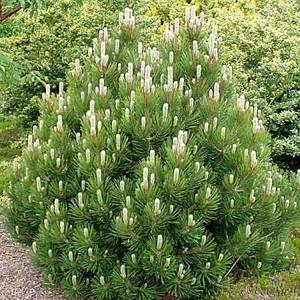
It is recommended to water only 3-4 times during the season; 10-20 liters will be enough for one tree. Loosening is necessary only when the soil is very compacted. Tolerates pruning well.
Decorative forms and young seedlings are vulnerable to low temperatures, so they must be covered with spruce branches for the winter. Older pines survive winters well and do not require additional care.
